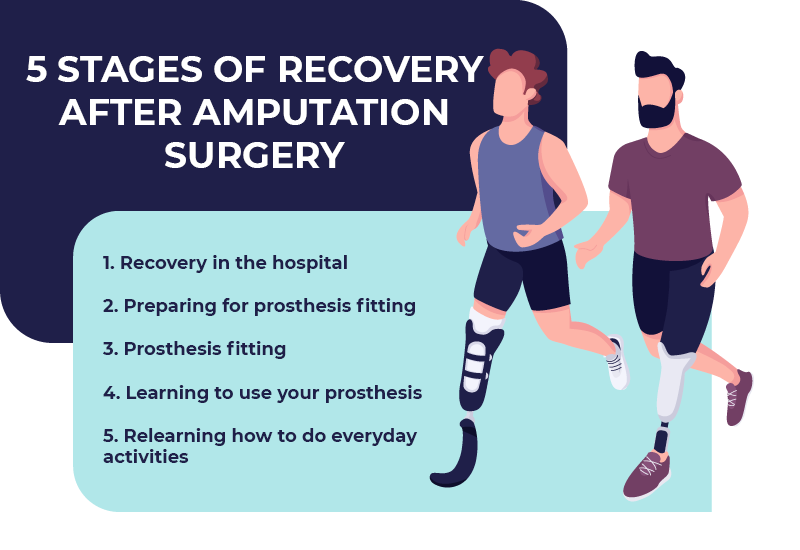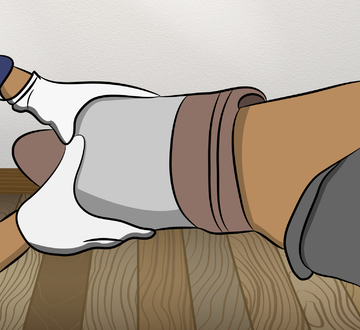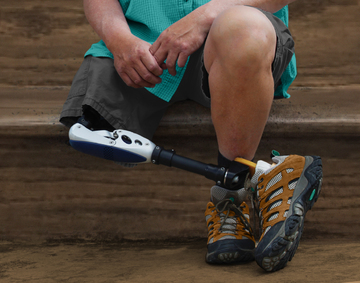One of the questions a new amputee is bound to ask once they have an amputation is, “What happens next?”
After amputation, you’re going to go through different stages towards recovery. This article tells you what might happen, what you need to do, and what you can expect during each stage in your journey towards recovery.
There will be times you’re going to feel that your recovery is taking longer than you want it to be. You need to summon lots of patience during these times because that’s just the way recovery after amputation is. You can’t rush it.
Keep in mind that your progress will depend on several factors such as your overall health, your age, and your diagnosis. The timeline is different for everyone.

Recovery in the Hospital
After the surgery, you’re most likely to stay in the hospital for about a week. Older people or those with preexisting health conditions might need to stay longer.
Hospital recovery aims to help you control pain, take care of your wound while it’s healing, keep your muscles strong, learn to move safely from the bed, learn to walk using crutches or other walking aids, and perform daily living activities.
Preparing For Prosthesis Fitting
Once you’ve recovered and are allowed to go home, you’ll need to prepare yourself for prosthesis fitting. This can take up to four weeks. During this stage, you need to be able to take care of your wound while also keeping your residual limb strong.
It’s best to massage your limb with soft kneading motions to get it used to touch. You also need to make sure you keep doing the exercise you did at the hospital. It’s also important to not miss any of your follow-up checkups. Remember that you need to keep yourself safe all the time and prevent falls so that you can recover fast.
Keep your amputation team’s contact details handy as you might need their help during recovery.
Visit your surgeon if you see the smallest signs of infection in your wound. Keep a close watch for sores or wounds. You must call your doctor in case of a fall or you hurt your residual limb.
Prosthesis Fitting

This part is probably one of the moments a new amputee is looking forward to in the whole process of recovery. You’ll get to this part only when your wound has healed and the stitches or staples are gone.
Remember to keep taking care of your residual limb. Your residual limb must be in the right position. This way, you prevent contracture or muscle shortening and tightening. Contracture may interfere with proper prosthetic gaits and require you to exert more effort when moving.
Here are a few things a new amputee needs to remember to prevent contracture:
- Always support your residual limb when you’re seated. Don’t let it hang or dangle.
- Spend fifteen to twenty minutes a day lying flat on your stomach to stretch the muscles at the front of your hip.
- When lying or sitting down, keep your residual limb flat and your knee as straight as possible.
- Keep your residual limb close to your good leg. Moving it outward too much may make it hard for you to walk with a prosthesis.
If you have a lot of swelling, this is your body trying to heal itself. At this stage, you might need a residual limb shrinker or just “shrinker.” You might also hear people call it a “stump shrinker.”

The use of a shrinker, applied with a donning tube can help control swelling (edema).
What it does is essentially give your residual limb a hug. There are different strengths to these shrinkers and their purpose is to apply even pressure to your residual limb to reduce swelling.
What these shrinkers try to do is gradually shrink down your residual limb. And the reason why that’s important is that, oftentimes, your pain levels will go down if you wear a shrinker, but also if you’re preparing for this prosthesis and preparing to get seen by the prosthetist.
In that case, if your swelling is at its maximum and you’re given a prosthesis, especially this thing called a “socket”. Ultimately, you’ll be given a socket, and that’s where you put your residual limb into. Once you go through a process of healing and shrinking, you will also go down in size gradually.
So, what’s going to happen? (A) It’s probably a good thing that you’re going down in size and swelling, but (B) if you’re given one of these sockets too quickly, you will basically swim around inside that prosthesis, and having too much room inside your prosthesis will not help your stability.
You really need to shrink down as much as you can, that’s why you’re given the shrinker. You can’t force the process; it takes time. When you’ve shrunk down – and not only are you down to a nominal level of shrinking, but you’ve also kept it off for a while – that’s usually when the prosthetist will start to get more active with you to get a new prosthesis. Getting the shrinking of the residual limb under control is a very important part of the process.
A shrinker is usually best provided by a prosthetist, and oftentimes you will get more than one for hygiene purposes. Also, you might shrink down onto the next size before you see your prosthetist next. There are instances where people would get a size 5 and then a size 4 once the person is ready. Your prosthetist might be able to do this, so you need to talk to them about it. It might be best to just take it day by day, though, and definitely have a conversation with your prosthetist on what the best practices would be for you.
All throughout your recovery period, make sure to talk to your physical therapist in case you feel any stiffness or you have trouble walking and doing your exercises.
Learning to Use Your Prosthesis
You will be using a preparatory prosthesis until your residual limb is at a stable size. It may take two months or up to six months before you get your permanent prosthesis. Some people continue to use their preparatory prosthesis as their permanent prosthesis.
At this stage, you must be able to put on and take off your prosthesis safely. You’ll also learn to adjust the sock ply and walk with your prosthesis using parallel bars. You’ll then move on to walking with the help of a walker or cane and then walk without aid when you can.
The important thing is that you keep yourself from falling as you slowly increase the length of time the prosthesis is worn every day.
You’ll also need to learn how to take care of and clean your prosthesis.
Don’t hesitate to talk to your prosthetist if you feel that your prosthesis feels uncomfortable or loose.
Relearning How To Do Everyday Activities
 Once you’re comfortable with using your prosthesis, you may be able to return to the activities you used to do. This part can be challenging and you might need to ask for support from your family and friends.
Once you’re comfortable with using your prosthesis, you may be able to return to the activities you used to do. This part can be challenging and you might need to ask for support from your family and friends.
Remember that your health should be your priority and to do that, you need to have a healthcare team to take care of you. It might also help if you start looking for ways to deal with the challenges that come with being a new amputee. Meditation and relaxation are great examples of coping techniques, however, don’t hesitate to go to a psychologist if you think you need professional support.
